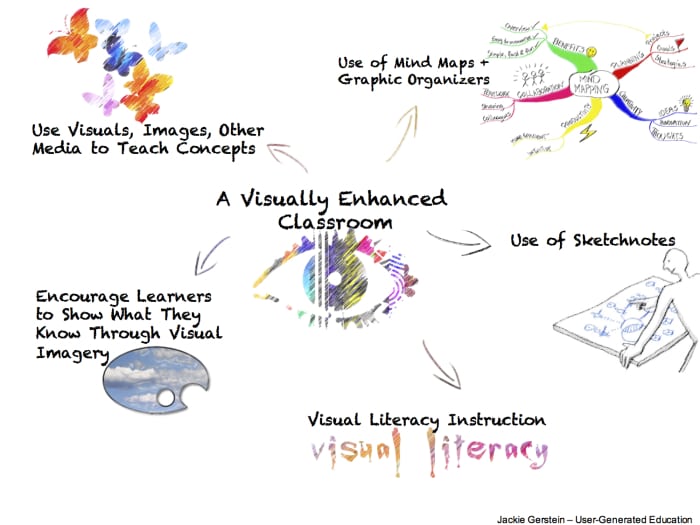Are you someone who remembers faces better than names or finds it easier to learn through pictures rather than words? If so, you might be a visual learner—and that means your study techniques should match how your brain works best.
Using the right methods can make your study sessions more effective and less stressful. Imagine turning complicated notes into colorful mind maps or flashcards that catch your eye and stick in your memory. You’ll discover simple but powerful study techniques designed just for visual learners like you.
Ready to transform your learning experience and boost your grades? Let’s dive into the strategies that will make your study time smarter, faster, and more enjoyable.

Credit: en.bigbyteedu.com
Visual Aids For Study
Visual aids help learners see and understand study material better. They turn text into pictures, making ideas easier to remember. Visual learners benefit from tools that organize information clearly and attractively.
Using visual aids can improve focus and make studying less tiring. These methods break down complex topics into simple, visual parts. Visual aids also help link ideas together, creating a strong memory path.
Mind Maps And Diagrams
Mind maps show ideas and their connections in a simple, visual way. Draw a central idea in the middle and add branches for related points. Diagrams like flowcharts explain processes step-by-step. These tools help organize thoughts and see the big picture quickly.
Flashcards With Images
Flashcards work well when paired with pictures or symbols. Add images to represent words or concepts for easier recall. Visual flashcards help learners associate information with a clear image. Carry flashcards anywhere for quick and active review sessions.
Timelines And Infographics
Timelines arrange events in order, showing how things change over time. They make history or processes easier to follow. Infographics combine images, charts, and short text to explain complex data. Both tools turn heavy information into visual stories that stick in the mind.
Color And Organization
Color and organization boost learning for visual learners. Using colors helps separate ideas clearly. Organizing study materials makes it easier to find information. Together, these techniques create a more engaging and efficient study process.
Color-coding Notes
Color-coding notes divides information into categories. Use different colors for terms, definitions, and examples. This method makes important points stand out quickly. Visual learners can recall color associations better than plain text. It also helps spot connections between ideas at a glance.
Highlighting Key Points
Highlighting draws attention to essential facts and concepts. Choose bright colors that contrast well with your notes. Highlight only the most important parts to avoid clutter. This technique guides your eyes to key information during review. It saves time and improves memory by focusing on what matters most.
Organized Study Space
Keep your study space neat and visually appealing. Arrange materials like books, notes, and supplies in order. Use folders or trays to separate subjects or topics. A tidy area reduces distractions and helps maintain focus. Visual learners benefit from a clean, organized environment that supports their study habits.
External Visual Resources
Visual learners benefit greatly from external visual resources. These tools provide clear pictures and examples. They help in understanding and remembering information better. Using visual aids outside textbooks makes learning more interactive and enjoyable.
These resources include videos, demonstrations, and images. Each type helps break down complex ideas into simple visuals. Visual learners can use these tools to improve focus and retention. Choosing the right external resources enhances the study experience.
Educational Videos
Educational videos present information through moving images and sound. They explain topics step-by-step with visual cues. Videos often include animations, charts, and real-life examples. Watching these can clarify difficult subjects quickly. Platforms like YouTube offer many free educational videos. Videos keep visual learners engaged and make studying less boring.
Visual Demonstrations
Visual demonstrations show how things work or are done. These can be live or recorded presentations. Demonstrations help by showing real actions instead of just words. They make abstract ideas easier to understand. Teachers or online tutorials often use this method. Seeing a process visually helps memory and comprehension.
Images And Graphics Online
Images and graphics online offer colorful and detailed visuals. Diagrams, charts, and infographics organize information clearly. Searching online provides a wide variety of study aids. These visuals can summarize facts in a simple way. Visual learners can save or print these for quick review. Using images supports faster learning and better recall.

Credit: www.teachthought.com
Note-taking Techniques
Note-taking is a key skill for visual learners. It helps capture information in ways that are easy to see and remember. Effective note-taking turns words into visual cues. This makes studying clearer and faster.
Detailed Notes
Write notes with clear and complete information. Use bullet points to break down ideas. Add diagrams or small sketches to explain concepts visually. Detailed notes help you understand and recall information easily.
Review And Rewrite
Go over your notes after class. Rewrite them to improve clarity and add colors or symbols. This process helps your brain remember information better. Rewriting also makes notes neat and organized for quick review.
Using Handouts
Use handouts as a visual aid during study. Highlight key points and write comments in the margins. Connect handouts with your notes by adding drawings or charts. Handouts give extra visual support for learning important ideas.
Memory Boosting Tips
Memory plays a big role in learning for visual learners. Simple tips can help improve recall and understanding. Using visual elements can make information easier to remember. These memory boosting tips suit visual learners well.
Associating Images With Concepts
Linking pictures to ideas helps your brain store information better. Create mental images that represent key points. For example, imagine a tree when learning about growth. This makes abstract concepts more concrete and memorable.
Try to visualize information as clear, colorful pictures. The stronger the image, the easier it is to recall. Use real-life objects or scenes to build these associations.
Using Symbols And Drawings
Draw simple symbols or sketches next to your notes. These visuals act as quick reminders of the main ideas. For instance, a light bulb can symbolize a new idea or concept. Use symbols that feel natural and easy to recognize.
Drawing helps engage your brain in a different way. It breaks down complex information into visual chunks. This method makes studying more interactive and less boring.
Visual Storytelling
Create stories that connect different images and ideas. Visual storytelling links facts in a sequence that your mind can follow. Imagine a story unfolding with characters and settings related to your study topic.
This technique turns isolated facts into a connected story. It is easier to remember stories than random facts. Use colors and shapes to make your story vivid and clear.

Credit: www.psychologicalscience.org
Improving Focus Visually
Visual learners absorb information best through images and spatial understanding. Improving focus visually helps these learners stay engaged and retain more knowledge. Using clear visual cues can guide attention and reduce mental clutter. Organizing study time and materials visually creates a structured environment. This approach makes it easier to follow study plans and track progress.
Creating A Visual Study Schedule
Design a study schedule using colors and shapes. Assign different colors to subjects or tasks for quick recognition. Use icons or symbols to mark breaks and important deadlines. Place the schedule where it is easy to see, like on a wall or desk. This constant visual reminder helps maintain focus and keeps goals clear.
Minimizing Visual Distractions
Clear the study area of unnecessary items to reduce distractions. Keep only study materials and tools in sight. Use plain backgrounds or a tidy desk to avoid overwhelming the eyes. Limit screen notifications and clutter on digital devices. A calm, simple space allows the mind to concentrate better on visual content.
Using Timetables And Planners
Use timetables and planners that include visual elements like charts and blocks. Block out study sessions and free time with different colors. Write tasks in bold or underline key points. Visual planners make it easier to see how time is allocated. This clarity improves time management and helps prevent last-minute cramming.
Tools And Apps For Visual Learners
Visual learners grasp information best through images and spatial understanding. Using the right tools and apps can make studying more effective. These digital resources help organize ideas and boost memory. They turn complex topics into simple visual formats.
Here are some useful tools that support visual learning.
Mind Mapping Software
Mind mapping apps let users create diagrams that connect ideas. This method shows relationships between concepts clearly. Popular software like MindMeister or XMind offers easy drag-and-drop features. Visual learners can color-code branches to highlight key points. Mind maps improve focus and help remember details better.
Flashcard Apps
Flashcard apps help reinforce memory with images and short text. Tools like Anki and Quizlet allow adding pictures to cards. Visual learners benefit from seeing icons alongside words. These apps support spaced repetition for better long-term recall. Flashcards make reviewing quick and engaging.
Note Organization Tools
Note-taking apps organize information visually with folders and tags. Evernote and OneNote let users insert images, sketches, and diagrams into notes. This creates a rich visual study environment. Organizing notes by color or subject helps find content easily. Visual learners stay organized and absorb material faster.
Frequently Asked Questions
What Are Visual Learning Techniques?
Visual learning techniques use images, diagrams, color-coding, and mind maps to help learners understand and remember information visually.
What Are The Four Types Of Study Techniques?
The four types of study techniques are visual, auditory, reading/writing, and kinesthetic learning. Each suits different learning preferences.
Which Teaching Strategies Are Likely To Be Most Effective For Visual Learners?
Effective teaching strategies for visual learners include using color-coded notes, mind maps, diagrams, flashcards with images, and educational videos. Organizing study materials visually and incorporating charts or infographics also boosts understanding and retention for these learners.
What Strategy Do Visual Learners Prefer?
Visual learners prefer strategies like color-coding notes, creating mind maps, diagrams, and using image-based flashcards for better retention.
Conclusion
Visual learners benefit from clear, colorful, and organized study methods. Using diagrams, charts, and flashcards helps remember key points. Watching videos and rewriting notes with drawings supports better understanding. Keeping study materials neat and visually appealing boosts focus. Trying different visual techniques reveals what works best for each person.
Consistent practice with these methods improves learning over time. Stay patient and keep exploring new visual tools. Success comes with effort and smart study habits.